2011 Week 9
After the hectic pace of Tidewater Archaeology Weekend, the crew this week had a lot of finishing up to do. The last week of field school is always a time of bittersweet feelings. Over the past nine weeks, the crew has come to rely on each other, both on the site and off, yet within a short time, will be gone. Many will not see each other again.
I decided to remove another quarter of the cellar so that a complete profile could be drawn showing details of the stratigraphy. Three volunteers took over this task and managed to get through to the bottom of the cellar.

Students Ben Garbart, Ben Pollack and Jean Drzyzgula stand in the completed cellar excavation.
As in the previous section, the top was full of plaster from the Calvert House while the lower stratum contained early period artifacts, including a number of terra cotta pipes. One of the most impressive of these had dentate incising in the form of rings and diamonds on the stem.
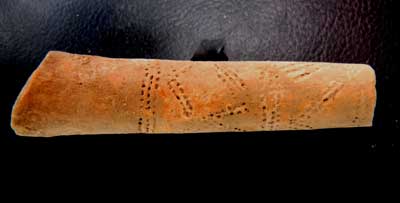
Decorated terra cotta pipe stem from the cellar hole fill.
We also worked to complete units in the midden area. .
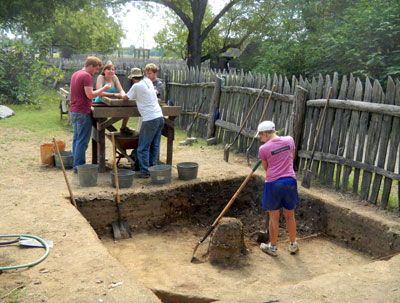
Students work to complete units in the midden area.
The photo shows the place where four separate squares come together. In the center, unexcavated, is a pedestal, containing the grid point shared by all four squares. This point will remain in place so that future archaeologists will be able to locate and define our grid. As discussed in previous weeks, the midden is extremely rich in artifacts and this week was no different. One of the more spectacular finds was a complete, molded pipe bowl.
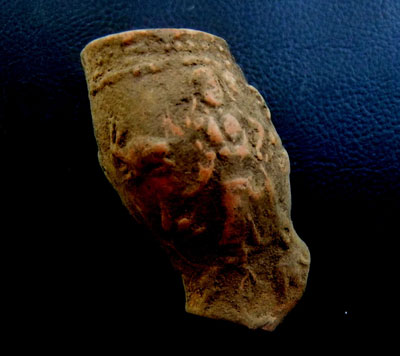
The “Minerva” side of a molded “Pikeman and Minerva” tobacco pipe bowl.
Known as a “Pikeman and Minerva” pipe, for the two figures molded on opposite sides of the bowl, these date to the 1670s. Two years ago, on the other side of the Calvert House, we found pieces of a pipe like this but it was not complete.
Another set of artifacts from the midden that caught the attention of the field school were fragments of a tin-glazed, earthernware plate.
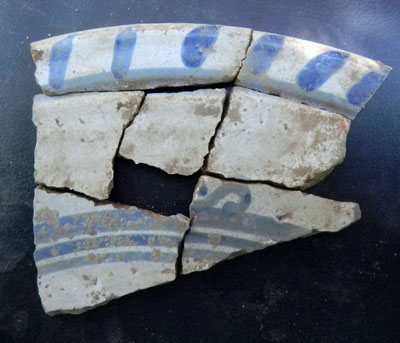
Fragments of a lead-backed, tin-glazed, earthenware plate.
These fragments, while found in the same unit, were not found together. They were scattered both horizontally and vertically in the midden. What brought them to our attention was that they do not have a tin glaze on the back of the sherds. Tin, which gives the glaze its white color, was very expensive and, early on, was only added to the glaze on the front of the vessel. Archaeologists refer to such ceramics as lead-backed, tin glaze and the practice stopped about the 1670s. As lead-backed, tin glaze is much rarer that the full kind, these sherds were noticed and, when they were seen to go together, excited much speculation.
Excavating the midden has been a unique experience, both for the field school and for myself. The number and quality of artifacts was exceptional. Late on Friday afternoon, I joked with the students that having found so much this summer, they should top it off with finding a religious medal. I turned around to walk back to the picnic table and had not gone more than 20 steps when a loud roar broke out behind me. As I turned around, the field school was jumping up in the air, hollering and hugging each other..

Silver medal/pierced coin.
Yes, they found a small piece of silver with a cross on it and a hole for hanging it. This may be a medal or it may be a pierced coin used to ward off the evil eye, but it fulfilled the conditions I set for them.
On the last day, as always, a group photo was taken.
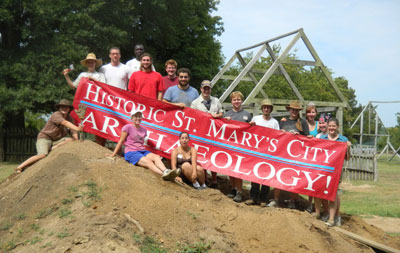
The 2010 Historic St. Mary’s City Archaeological Field School.
These students contributed greatly to the understanding of the Calvert House site. They worked diligently through one of the hottest summers on record. I extend my thanks and those of the institution for an interesting and eventful summer.


